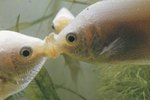
Flatworms belong to the phylum Platyhelminthes, literally meaning "flatworms" in Latin. Flatworm species are divided into three classes: Turbellaria, Trematoda and Cestoda. All flatworms, according to Cool Galapagos, are hermaphroditic, soft-bodied worms with rudimentary nervous systems, no respiratory or circulatory systems and simple digestive tracts with single openings.
Trematoda
The class Trematoda consists of flukes. Flukes are parasitic flatworms that require two hosts to complete their life cycle. They begin their lives in a lower life form like a snail, then move on to invade humans and other animals. Flukes, says Animal Planet, are generally found in the tropics and Far East, but can also be found in other parts of the world. They spread infection and disease in humans and animals. Common flukes include blood flukes, Chinese liver flukes and lancet liver flukes.
Cestoda
Over 1,500 species of tapeworms make up the class Cestoda. Tapeworms are parasitic flatworms that invade the intestinal tracts of animals and humans and are capable growing up to 75 feet long, causing infection, allergic reactions and disease. Once inside its host, the tapeworm uses suckers to attach its head to the intestinal wall. It absorbs nutrients from its host and continually produces new segments containing thousands of eggs, which are released through the host's feces.
Turbellaria
The class Turbellaria is composed of approximately 3,000 species of planaria. Planaria flatworms are typically nonparasitic, and can be found in fresh water, saltwater, and, less often, moist soil. According to Animal Planet, planarians use their cilia to glide through their environment. They can also move short distances using a brisk crawling motion. They feed on protozoa, bacteria, crustaceans, smaller worms, and animal and plant matter.
The Food Chain
Flatworms, according to Cool Galapagos, occupy varying links in food chains. As parasites, Cestodes and Trematodes are at the top of their respective food chains. They are eaten but not digested, or not consumed at all. On the other hand, Turbellarians are a regular food source for fish, amphibians, crustaceans and beetles. They also benefit the environment by consuming and regulating populations of protozoa, algae and rotifers.
References
Resources
Photo Credits
-
Jupiterimages/Photos.com/Getty Images
Writer Bio
Yvette Sajem has been a professional writer since 1995. Her work includes greeting cards and two children's books. A lifelong animal advocate, she is active in animal rescue and transport, and is particularly partial to senior and special needs animals.



